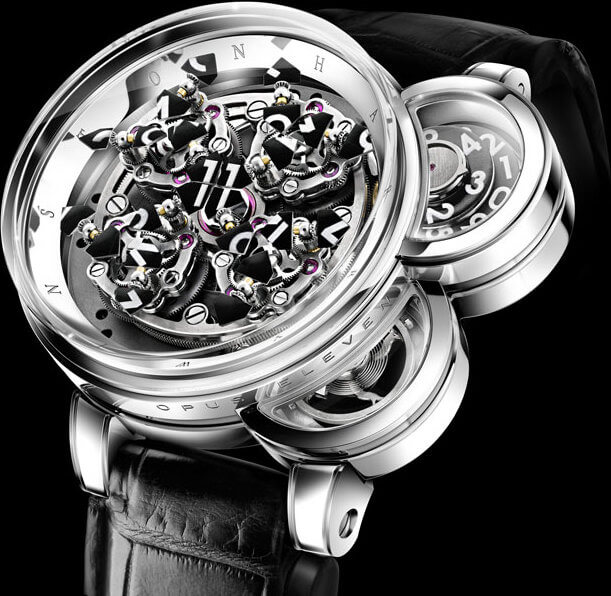If there is one timepiece that galvanises attention at Baselworld, that timepiece is the Opus. The concept, which Harry Winston launched eleven years ago, is to enlist the most gifted independent horologists to develop a watch that is exceptional both inside and out. Collectors long to secure one of these limited-edition timepieces which, unusually in the world of watchmaking, train the spotlight on their inventor.
14,400 hours to develop
Taking the stage this year, and with brio, is Denis Giguet. “I was looking for a new concept for a watch,” explains this former head of production at Harry Winston, who in 2007 set up Manufacture Contemporaine du Temps which is behind the Sequential One. “I started thinking about ways to explode time, to deconstruct it like a shoal of fish scattering. Digitale in Neuchâtel helped produce the initial sketches, and it wasn’t long before designer Eric Giroud came onboard. He was convinced the watch had everything to become part of the Opus series. Eric was already working with Harry Winston, so he set up a meeting to outline the project, and the partnership followed from there.”
Thus began work to develop a 566-component movement over 20 months – 14,400 hours – that would drive a watch with a CHF 220,000 (USD 263’000 / EUR 182’000) price tag, produced as a limited edition of 111 including eleven with diamonds. Denis Giguet and his suppliers would take care of the movement, Harry Winston the case. “If it had just been me and my brand, without funding from the partnership, it would have taken four years,” Giguet continues. “Not that money is the only advantage of working with such a big name. Bouncing ideas around always helps and the communication is an additional benefit for an independent watchmaker like me.”
Harry Winston Opus XI mechanism

Sold out even before the launch
Setting off this “explosion” inside a watch movement was no small feat, but Denis Giguet found a way to resolve the puzzle: “I imagined a circle with four satellites, each carrying three pairs of pallets. Four pallets come together to display the hour. There is no hand, just a numeral that disintegrates and reforms every hour in an apparently random, three-dimensional movement that is driven by a system of gears mounted on an epicycloidal gear train. The barrel is sufficiently powerful to keep the pallets rotating; the last thing we wanted was an instantaneous hour jump. The main difficulties were calculating the gears and, even more so, the rotations to prevent the pallets from colliding. Minutes are shown on two disks inside a pavilion which overlaps a second pavilion containing the large balance wheel.”
With the prototype shown in Basel under his belt, Denis Giguet reckons another month will be sufficient to finalise his timepiece prior to the production launch. Each movement takes four weeks to assemble. The first Opus Eleven are scheduled for autumn. Needless to say, all 111 watches are already spoken for.

















